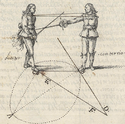|
|
You are not currently logged in. Are you accessing the unsecure (http) portal? Click here to switch to the secure portal. |
Difference between revisions of "Pablo de Paredes"
| Line 63: | Line 63: | ||
<li>Two talhos and a thrust turned backwards, and a revez entering and exiting.</li> | <li>Two talhos and a thrust turned backwards, and a revez entering and exiting.</li> | ||
<li>Three cenidos<ref>Cenido is probably analogous to the Portuguese cingido. I translated cingindo as circling in the Memorial, but there is likely more to it than that. Cegando is probably "sawing", meaning slicing not chopping (Capoferro uses this term as well), but it could also mean "blinding". Figueiredo doesn't give us enough info to clearly define it. I like firm-footed too, but in several traditions that term is used to describe a lunge, meaning that one foot is firm instead of both moving. That's my only reason for using "standing still".</ref> entering the turn with a talho and another three exiting, and the vuelta with a revez, this is to clear space.</li> | <li>Three cenidos<ref>Cenido is probably analogous to the Portuguese cingido. I translated cingindo as circling in the Memorial, but there is likely more to it than that. Cegando is probably "sawing", meaning slicing not chopping (Capoferro uses this term as well), but it could also mean "blinding". Figueiredo doesn't give us enough info to clearly define it. I like firm-footed too, but in several traditions that term is used to describe a lunge, meaning that one foot is firm instead of both moving. That's my only reason for using "standing still".</ref> entering the turn with a talho and another three exiting, and the vuelta with a revez, this is to clear space.</li> | ||
| − | <li>Three talhos and a thrust and a revez, and turning the back exit in the same manner, this is for a narrow street. | + | <li>Three talhos and a thrust and a revez, and turning the back exit in the same manner, this is for a narrow street.</li> |
<li>A talho and a thrust, entering, and exiting, this is guarding a cloak.</li> | <li>A talho and a thrust, entering, and exiting, this is guarding a cloak.</li> | ||
<li>A cegando talho, and another falling, and a thrust and with your revez, entering and exiting. This is for a round plaza.</li> | <li>A cegando talho, and another falling, and a thrust and with your revez, entering and exiting. This is for a round plaza.</li> | ||
Revision as of 14:31, 8 July 2016
| Pablo de Paredes | |
|---|---|
| Born | date of birth unknown |
| Died | after 1599 |
| Occupation | Fencing master |
| Movement | Esgrima común |
| Language | Spanish |
Pablo de Paredes (Paulo de Paredes) was a late 16th century Spanish fencing master. Little is known of this master's life, but he seems to have been the Head Master of Arms (Maestro Mayor) to the royal court of Spain in 1599. There he instructed Jehan L'Hermite, a Belgian and one of the prince's tutors, in the use of the montante and double side swords. The only known record of Paredes' teachings is a passage in L'Hermite's memoir, which records twelve rules for the montante but indicates that he had forgotten the double sword teachings.
Contents
Treatise
Transcription | |
|---|---|
Rules or Canons of the Two-Handed Sword:
|
Regles ou Canons de l’espée à deux mains.
|
For further information, including transcription and translation notes, see the discussion page.
| Work | Author(s) | Source | License |
|---|---|---|---|
| Translation | Eric Myers | ||
| Transcription | Charles Ruelens | Le Passetemps de Jehan L'Hermite |
Additional Resources
- L'Hermite, Jehan. Le Passetemps de Jehan L'Hermite. Antwerp: J. E. Buschmann, 1896.
References
- ↑ A Talho is a forehand blow.
- ↑ A Revez is a backhand blow.
- ↑ Vuelta could be a turn of the sword or the body, depending on context.
- ↑ Cenido is probably analogous to the Portuguese cingido. I translated cingindo as circling in the Memorial, but there is likely more to it than that. Cegando is probably "sawing", meaning slicing not chopping (Capoferro uses this term as well), but it could also mean "blinding". Figueiredo doesn't give us enough info to clearly define it. I like firm-footed too, but in several traditions that term is used to describe a lunge, meaning that one foot is firm instead of both moving. That's my only reason for using "standing still".
|
|||||||||||||||||||||||||||

